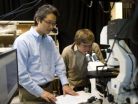(Press-News.org) CAMBRIDGE, Mass. -- About one-third of the human population is infected with a parasite called Toxoplasma gondii, but most of them don't know it. Though Toxoplasma causes no symptoms in most people, it can be harmful to individuals with suppressed immune systems, and to fetuses whose mothers become infected during pregnancy. Toxoplasma spores are found in dirt and easily infect farm animals such as cows, sheep, pigs and chickens. Humans can be infected by eating undercooked meat or unwashed vegetables.
Jeroen Saeij, an assistant professor of biology at MIT is investigating a key question: why certain strains of the Toxoplasma parasite (there are at least a dozen) are more dangerous to humans than others. He and his colleagues have focused their attention on the type II strain, which is the most common in the United States and Europe, and is also the most likely to produce symptoms. In a paper appearing in the Jan. 3 online edition of the Journal of Experimental Medicine, the researchers report the discovery of a new Toxoplasma protein that may help explain why type II is more virulent than others.
Toxoplasma infection rates vary around the world. In the United States, it's about 10 to 15 percent, while rates in Europe and Brazil are much higher, around 50 to 80 percent. However, these are only estimates — it is difficult to calculate precise rates because most infected people don't have any symptoms.
After an infection is established, the parasite forms cysts, which contain many slowly reproducing parasites, in muscle tissue and the brain. If the cysts rupture, immune cells called T cells will usually kill the parasites before they spread further. However, people with suppressed immune systems, such as AIDS patients or people undergoing chemotherapy, can't mount an effective defense.
"In AIDS patients, T cells are essentially gone, so once a cyst ruptures, it can infect more brain cells, which eventually causes real damage to the brain," says Saeij.
The infection can also cause birth defects, if the mother is infected for the first time while pregnant. (If she is already infected before becoming pregnant, there is usually no danger to the fetus.)
There are drugs that can kill the parasite when it first infects someone, but once cysts are formed, it is very difficult to eradicate them.
A few years ago, Saeij and colleagues showed that the Toxoplasma parasite secretes two proteins called rhoptry18 and rhoptry16 into the host cell. Those proteins allow the parasite to take over many host-cell functions.
In the new study, the MIT team showed that the parasite also secretes a protein called GRA15, which triggers inflammation in the host. All Toxoplasma strains have this protein, but only the version found in type II causes inflammation, an immune reaction that is meant to destroy invaders but can also damage the host's own tissues if unchecked. In the brain, inflammation can lead to encephalitis. This ability to cause inflammation likely explains why the type II strain is so much more hazardous for humans, says Saeij.
Saeij and his team, which included MIT Department of Biology graduate students Emily Rosowski and Diana Lu, showed that type II GRA15 leads to the activation of the transcription factor known as NF-kB, which eventually stimulates production of proteins that cause inflammation. The team is now trying to figure out how that interaction between GRA15 and NF-kB occurs, and why it is advantageous to the parasite.
Ultimately, Saeij hopes to figure out how the parasite is able to evade the immune system and establish a chronic infection. Such work could eventually lead to new drugs that block the parasite from establishing such an infection, or a vaccine that consists of a de-activated form of the parasite.
###
MIT Department of Biology graduate students Emily Rosowski and Diana Lu are the paper's two first authors and contributed equally to the research. Other authors include MIT postdoc Kirk Jensen, lab technician Lindsay Julien, MIT undergraduate student Lauren Rodda, and Rogier Gaiser, a graduate student at Wageningen University in the Netherlands.
Source: "Strain-specific activation of the NF-kB pathway by GRA15, a novel Toxoplasma gondii dense granule protein," by Emily E. Rosowski, Diana Lu, Lindsay Julien, Lauren Rodda, Rogier A. Gaiser, Kirk D.C. Jensen, Jeroen P.J. Saeij. Journal of Experimental Medicine, 3 January 2011.
Funding: American Heart Association, Massachusetts Life Sciences Center, Singapore-MIT Alliance for Research and Technology (SMART), National Institutes of Health, Cleo and Paul Schimmel Fund, Cancer Research Institute, MIT UROP office and the John Reed Fund.
END
Patients with early rheumatoid arthritis (RA) who are current smokers were less likely to achieve good response to methotrexate (MTX) and tumor necrosis factor (TNF) inhibitors than those who never smoked. The study by researchers from Sweden also found that RA patients who smoked in the past did not experience a lower response to these therapies. Results of the 10-year study appear in the January 2011 issue of Arthritis & Rheumatism, a journal published by Wiley-Blackwell on behalf of the American College of Rheumatology (ACR).
According to the World Health Organization ...
The presence of antinuclear antibodies (ANA) indicates the possibility of autoimmunity and the indirect immunofluorescence (IIF) assay on HEp-2 cells is the standard blood test (ANA-HEp-2) used to detect ANA. However, studies have shown that a "false-positive" ANA test occurs in up to 13% of healthy individuals. In such cases the test detects the presence of autoantibodies that apparently are not associated with autoimmunity. Researchers from Brazil have now uncovered distinguishing characteristics of the ANA test in healthy individuals and patients with autoimmune disease, ...
During a total eclipse of the Sun, skywatchers are awed by the shimmering corona -- a faint glow that surrounds the Sun like gossamer flower petals. This outer layer of the Sun's atmosphere is, paradoxically, hotter than the Sun's surface, but so tenuous that its light is overwhelmed by the much brighter solar disk. The corona becomes visible only when the Sun is blocked, which happens for just a few minutes during an eclipse.
Now, an instrument on board NASA's Solar Dynamics Observatory (SDO), developed by Smithsonian scientists, is giving unprecedented views of the ...
New research found clinicians who care for patients with osteoarthritis (OA) are likely not following standard care guidelines that are based on current medical evidence. Researchers noted physicians were prescribing medications for pain and inflammation, or opting for surgical interventions rather than recommending weight loss plans or exercise programs to OA patients. Details of the this study are available in the January 2011 issue of Arthritis Care & Research, a journal published by Wiley-Blackwell on behalf of the American College of Rheumatology.
A 2002 report ...
WEST LAFAYETTE, Ind. - Researchers are creating a new type of solar cell designed to self-repair like natural photosynthetic systems in plants by using carbon nanotubes and DNA, an approach aimed at increasing service life and reducing cost.
"We've created artificial photosystems using optical nanomaterials to harvest solar energy that is converted to electrical power," said Jong Hyun Choi, an assistant professor of mechanical engineering at Purdue University.
The design exploits the unusual electrical properties of structures called single-wall carbon nanotubes, using ...
More plant matter could be burned in coal-fired power stations if this 'green' fuel was delivered pre-roasted like coffee beans, according to researchers from the University of Leeds, UK.
Many UK power stations are now burning plant matter, or biomass, as well as coal in a bid to cut their carbon footprint. Unlike fossil fuels, plants like willow, Miscanthus and poplar are a virtually carbon-neutral source of energy: the carbon dioxide emitted when they burn is absorbed during photosynthesis by the next batch of 'energy crops' planted in their place.
But the environmental ...
WEST LAFAYETTE, Ind. - The United States doesn't have the infrastructure to meet the federal mandate for renewable fuel use with ethanol but could meet the standard with significant increases in cellulosic and next-generation biofuels, according to a Purdue University study.
Wally Tyner, the James and Lois Ackerman Professor of Agricultural Economics, and co-authors Frank Dooley, a Purdue professor of agricultural economics, and Daniela Viteri, a former Purdue graduate student, used U.S. Department of Energy and Environmental Protection Agency data to determine that the ...
WASHINGTON, Jan. 4, 2011 — A special edition of the American Chemical Society journal, Environmental Science & Technology (ES&T), one of the world's premier environmental journals, is available now for a limited time online without charge. The special edition will be accessible free during 2011, when the world celebrates the International Year of Chemistry.
Entitled "Environmental Policy: Past, Present, and Future," the special issue of ES&T recognizes closure of a "green" decade in which people became more aware of environmental issues, and society marked the 40th anniversaries ...
NEW YORK (Jan. 4, 2011) — Researchers have produced a lasting anti-cocaine immunity in mice by giving them a safe vaccine that combines bits of the common cold virus with a particle that mimics cocaine.
In their study, published Jan. 4 in the online edition of Molecular Therapy and funded by the National Institute on Drug Abuse, the researchers say this novel strategy might be the first to offer cocaine addicts a fairly simple way to break and reverse their habit, and it might also be useful in treating other addictions, such as to nicotine, heroin and other opiates.
...
RICHMOND, Va. (Jan. 4, 2011) – Virginia Commonwealth University School of Medicine researchers have found that a significant increase of an enzyme in the blood vessels of pregnant women with preeclampsia may explain some of the symptoms associated with the condition, including hypertension, swelling and protein in the urine.
The findings could lead to a treatment for pregnant women with preeclampsia, which is one of the most significant health problems in pregnancy and a leading cause worldwide of both premature delivery and of sickness and death of the mother and baby.
Preeclampsia, ...


